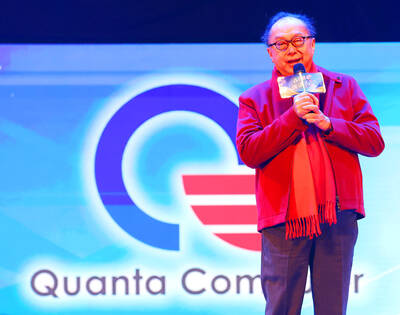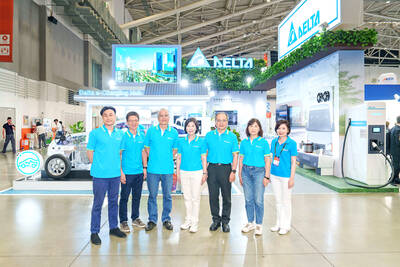Nanya Technology Corp (南亞科技), the nation’s biggest computer memory chipmaker, swung back into losses in the first quarter, because of limited output due to technology migration and weak pricing in the contract chip market, a company executive said yesterday.
After posting a moderate profit of NT$199 million (US$6.3 million) in the fourth quarter of last year — ending 10 consecutive quarters of losses — Nanya sank back into the red in the first quarter with a loss of NT$1.63 billion.
Compared with a year ago, however, this was a vast improvement from a loss of NT$10.51 billion.
Nanya’s average selling price slid 5 percent quarter-on-quarter in the first quarter, and shipments fell 10 percent, the company said.
The company was optimistic, however, that prospects would pick up in the following quarters.
“The first quarter should be the trough in terms of shipments and revenue,” company spokesman Pai Pei-ling (白培霖) said. “The second quarter will not be a slow season like it used to be. PC makers are trying to build enough inventory, but none of them can get enough chips.”
“Some even have to disrupt production last month because of a shortage of DDR3 [supply],” he said.
DDR3 is expected to replace DDR2 as the mainstream PC memory chip sometime this year.
This quarter, output is expected to grow 10 percent from last quarter, and the average selling price is projected to rise from the first quarter, he said.
“We are not worried about demand ... massive replacement demand is expected to emerge in the middle of this quarter and continue through the third quarter, while supply will increase relatively slowly,” Pai said.
That strong demand could help Nanya Technology return to the black next quarter, aided by a new wave of corporate PC replacement demand and a 10 to 20 percent quarterly improvement in cost after completing its migration to 50-nanometer technology this quarter, Pai said.
That matched the expectations of Liu Szu-liang (劉思良), an analyst with Yuanta Securities and Investment Consulting (元大投顧).
“Nanya Technology may not be able to make a profit until the third quarter, as its technology migration is weighing on operations,” Liu said.
The new DDR3 chips are expected to account for half of the company’s shipments this quarter and rise to 80 percent by the end of the year, up from about 40 percent in the first quarter, as it continues its technology migration, he said.
This year, PC shipments are expected to grow 20 percent year-on-year, making it another boom year for the PC sector, Nanya Technology forecast.
To speed up the technology migration, Nanya Technology raised its forecast capital spending this year to NT$22 billion, up 18 percent from the NT$20 billion it estimated three months ago. That would also represent a nearly 50 percent increase from last year’s NT$14.6 billion.
Most of the expenditure would go into the migration to 50nm and 42nm process technologies, the company said.
Nanya Technology is planning to start small volume production of chips on advanced 42nm process technology, aiming to ramp up production in the fourth quarter.
Separately, Inotera Memories Inc (華亞科技), a joint venture between Nanya Technology and US memory company Micron Technology Inc, yesterday reported a loss of NT$1.56 billion for the first quarter.
This compares with a loss of NT$5.32 billion a year ago and a profit of NT$475 million in the fourth quarter of last year.

Quanta Computer Inc (廣達) chairman Barry Lam (林百里) is expected to share his views about the artificial intelligence (AI) industry’s prospects during his speech at the company’s 37th anniversary ceremony, as AI servers have become a new growth engine for the equipment manufacturing service provider. Lam’s speech is much anticipated, as Quanta has risen as one of the world’s major AI server suppliers. The company reported a 30 percent year-on-year growth in consolidated revenue to NT$1.41 trillion (US$43.35 billion) last year, thanks to fast-growing demand for servers, especially those with AI capabilities. The company told investors in November last year that

Intel Corp has named Tasha Chuang (莊蓓瑜) to lead Intel Taiwan in a bid to reinforce relations between the company and its Taiwanese partners. The appointment of Chuang as general manager for Intel Taiwan takes effect on Thursday, the firm said in a statement yesterday. Chuang is to lead her team in Taiwan to pursue product development and sales growth in an effort to reinforce the company’s ties with its partners and clients, Intel said. Chuang was previously in charge of managing Intel’s ties with leading Taiwanese PC brand Asustek Computer Inc (華碩), which included helping Asustek strengthen its global businesses, the company

Taiwanese suppliers to Taiwan Semiconductor Manufacturing Co. (TSMC, 台積電) are expected to follow the contract chipmaker’s step to invest in the US, but their relocation may be seven to eight years away, Minister of Economic Affairs J.W. Kuo (郭智輝) said yesterday. When asked by opposition Chinese Nationalist Party (KMT) Legislator Niu Hsu-ting (牛煦庭) in the legislature about growing concerns that TSMC’s huge investments in the US will prompt its suppliers to follow suit, Kuo said based on the chipmaker’s current limited production volume, it is unlikely to lead its supply chain to go there for now. “Unless TSMC completes its planned six

Power supply and electronic components maker Delta Electronics Inc (台達電) yesterday said it plans to ship its new 1 megawatt charging systems for electric trucks and buses in the first half of next year at the earliest. The new charging piles, which deliver up to 1 megawatt of charging power, are designed for heavy-duty electric vehicles, and support a maximum current of 1,500 amperes and output of 1,250 volts, Delta said in a news release. “If everything goes smoothly, we could begin shipping those new charging systems as early as in the first half of next year,” a company official said. The new